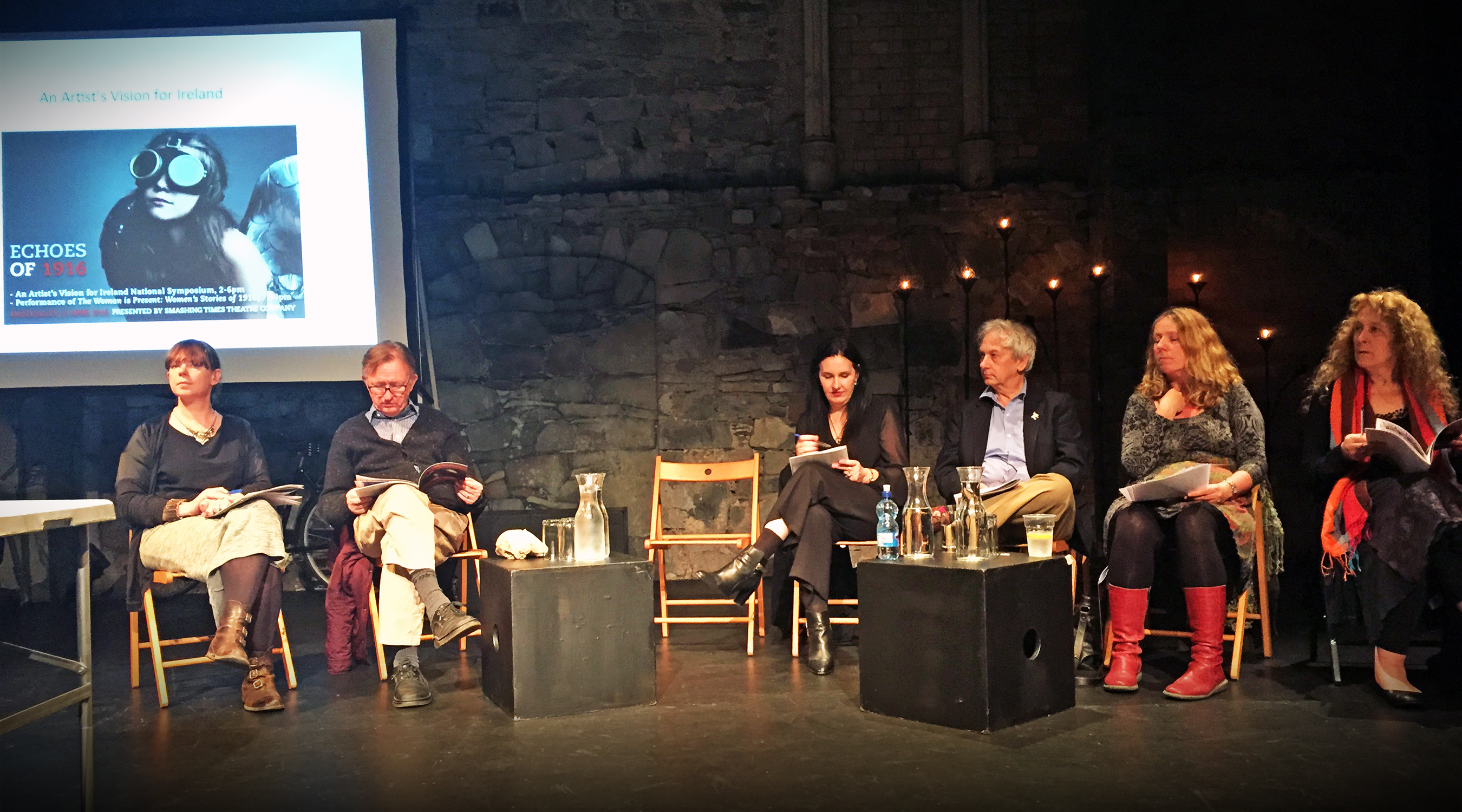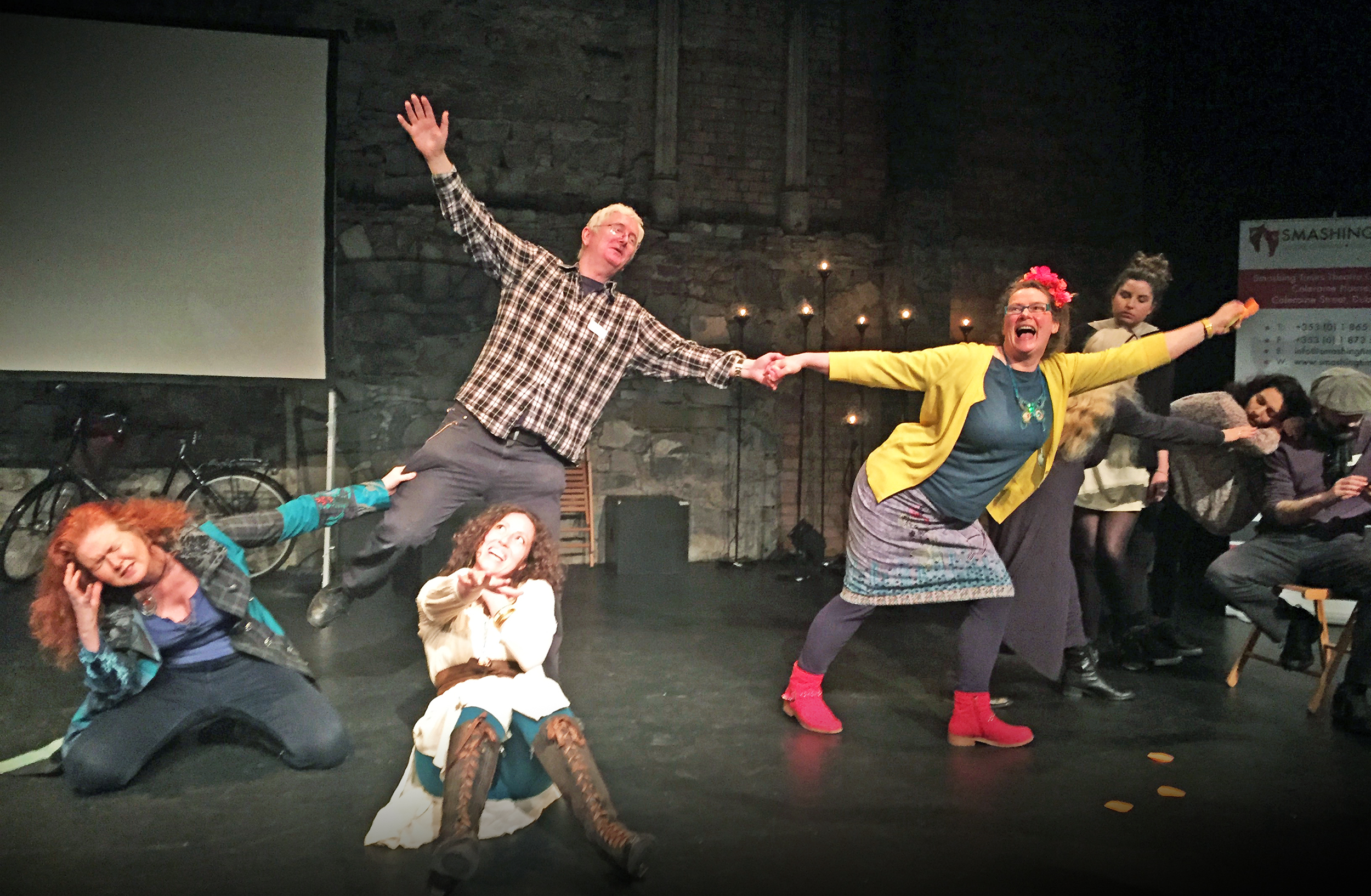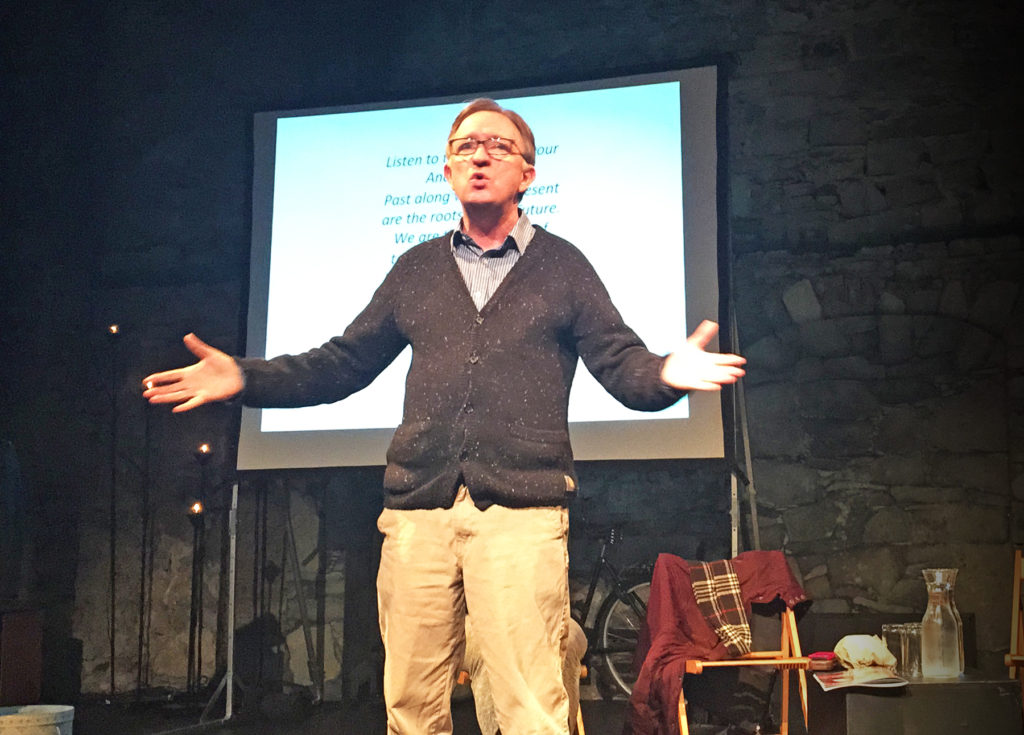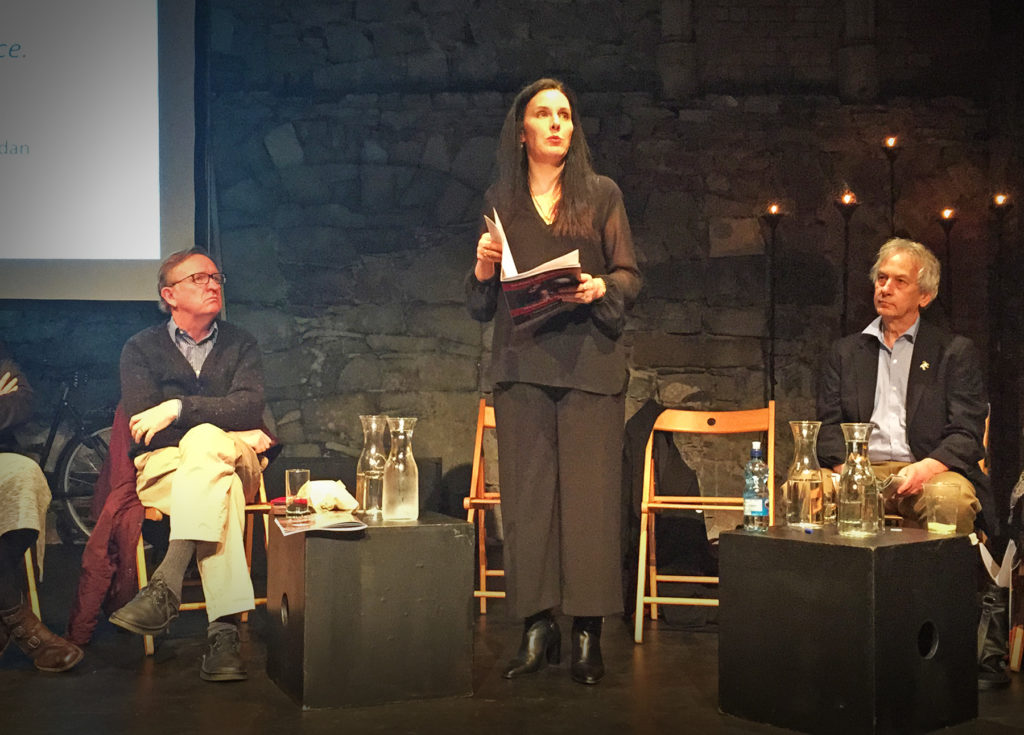
‘Informative, provocative, stimulating and enjoyable!’
– Arnold Thomas Fanning
‘Thank you for creating a space for artists to come together. To be able to talk and share is so important.’ – Emma Lame
‘I found the symposium inspiring’. – Nitai Heksiewiez
‘Take back the power . . . believe the unbelievable, stop doubting our own talent and look boldly, bravely to the future’ – Deirdre Kinahan
On Thursday 21 April 2016 Smashing Times Theatre Company presented an Artist Vision for Ireland National Symposium from 2 to 6pm followed by the Irish premiere of The Woman is Present: Women’s Stories of 1916 at 7.30pm at Smock Alley Theatre, Dublin. The live performance of The Woman is Present: Women’s Stories of 1916 featured original testimony and new Irish writing by Pom Boyd, Mary Moynihan and Peter Sheridan and is a new performance inspired by and about the women of 1916.

The original title An Artist’s Vision for Ireland came from actor and Smashing Times founding board member Margaret Toomey. Margaret’s relatives fought in 1916, the Toomey family of Phibsboro Road in Dublin, six of whom were intensely involved. They were sisters Stasie and Nellie of Cumann na mBan and Margaret of Inghinidhe na hÉireann and their brothers Joe, Sean and Eddie of the Irish Volunteers. *
As a member of Smashing Times, Margaret commented on the fact that so many artists were involved in the Rising and suggested we support a gathering of artists and all those interested in the arts, to come together in 2016 to explore and debate on what vision or possibilities we want for the future. So the idea of the Artist’s Vision for Ireland symposium was born to be presented at Smock Alley Theatre, Dublin, during the 100th anniversary year of the Rising.
There were seven signatories to the Irish Proclamation, all men, so Smashing Times decided to ask artists, both women and men, to write out their own draft manifesto inspired by the theme An Artist’s Vision for Ireland. The manifesto is a starting point, a shared vision for further discussion. The manifestoes are creative imaginings from a range of artists from personal reflection, to creative musing to radical political visions for the future and encompassing all art forms and all areas of life. The seven manifestos are a sharing of ideas from Pom Boyd, Eimear Burke, Bryony May, Jenny Macdonald, Mary Moynihan, Peter Sheridan and Karen Ward.

Ray Yeates, Dublin Arts Officer 
Mary Moynihan, Smashing Times Artist
Five creative art practitioners spoke at the symposium. The key note speech was presented by Deirdre Kinahan, playwright, followed by presentations by Emer O’Boyle, Visual Artist and Director of UCD Parity Studio, Ray Yeates, Dublin City Council Arts Officer, Mary Moynihan,
Theatre and Film Maker, Artistic Director, Smashing Times, and Dr Eric Weitz, Associate Professor of Drama, Trinity College Dublin and board member of Smashing Times.
Click here to see the book An Artist’s Vision for Ireland containing information on the National Symposium, a performance of The Woman is Present: Women’s Stories of 1916 and the full text of seven Artist Manifestoes and five speeches on the theme of An Artist’s Vision for Ireland.

*Extract from speech on the Toomey Family involvement in 1916
One family involved in the Easter Rising of 1916 were the Toomey’s of 88 Phibsboro Rad in Dublin, six of whom were intensely involved in the Rising of 1916; Joe, Sean and Eddie of the Irish Volunteers; their sisters Stasie and Nellie of Cumann na mBan and still another Margaret, of the earlier Ininghide na hEireann. The major influence, which stimulated their interest in a free and independent Ireland, was unquestionably that of their mother Mary Anne, a Wexford woman who imbued them with this sentiment practically from the moment they were born. The family history recounts that as a young woman she had kissed he icon Parnell in the Bull Ring in Wexford. Her husband, John Charles Toomey, died young and Mary Anne persuaded her grandfather, a cattle dealer and well-off farmer to move to Dublin where she believed her children would get a better education.
By the time of the 1916 Rising she was steeped in all the nationalist political activity there. Her family was now all grown up and she lived in 88 Phibsboro Road with her daughter Maggie and her husband Greg Foley. Their home became a safe house for Republicans who were on the run. Dan Breen was brought there after the attack in Ashtown, County Meath in 1919. She put him into her own bed and nursed his wounds. Undoubtedly she was one of those gallant women whom he described in his autobiography as the real heroines of the War of Independence.
Mary Anne’s grand-daughter Neil Lawlor recalls that’ ‘although the neighbours in Phibsboro knew that the Toomey home was a safe house, they were never betrayed even when the Black and Tans came searching the area’’. Mary Anne, a matriarchal figure, lived to a ripe old age and gave instructions that her funeral cortege was to be pulled by a team of six plumed black horses.
The children were as intrepid as she; three of them were in the GPO with James Connolly. Stasia attended him when he was injured; she cleaned his wounds with antiseptic ointment and bandaged it securely. When she grew frightened at the gunfire he noticed and said to her ‘’Stasia have a cigarette – it will calm you.’ ‘’I don’t smoke’’ she replied. ‘’It will do you good’’ said Connolly. She took the cigarette and smoke for the rest of her life!
Her sister Nellie was secretary to Cathal O’Shannon when he was an official of the Irish Transport and General Workers Union. A committed socialist she was very often seen on the back of her brother Sean’s motorbike as they travelled all over the country on Sinn Fein business. Sadly she contracted the 1918 flu, which decimated millions in Britain, Ireland the European mainland. This later turned into tuberculosis, which ended her young life, she died on the 13 October 1923. Her guileless, irrepressible joie-de-vivre is described beautifully in the obituary tribute to her by a colleague ‘P’ in the October 13, 1923 issue of The Voice of Labour.
Her brother Joe Toomey’s contribution to the events of 1916 has been outlined by the historian Padraig Yeates in his major history of that period ‘A City of Turmoil – Dublin 1919-1921’’. He recounts how Toomey ‘’almost certainly a member of the IRB and a fitter by trade was involved with other Irish craftsmen in the breakaway from their British Union, the Amalgamated Society of Engineers (ASE) to form their own Irish craft union ‘’ a fusion of then different trades into one big Irish engineering union’, the IESFTU. This idea was the brainchild of the Minister for Labour, Countess Markievicz and was launched at a mass meeting of seven hundred (700) craftsmen in the Abbey Theatre on Sunday 9 May 1920. Its main advocate was Joseph Toomey, who said that ‘’the interests of Irish workers differed increasingly with those across the channel’’. Examples cited were ‘’the failure of the ASE to issue strike pay during the 1913 general strike against conscription and its lack of support for the 1913 lockout.’’ Yeates points that all the main movers in this development ‘’had strong links with the independence movement’’ and further ‘’that Toomey, a colleague Thomas Maguire and others’’ were part of an IRA group that used their specialist skills to manufacture hand grenades and ammunition’’.
His home at 31 Clonliffe Avenue was raided by a squad from the Lancashire Fusiliers where they found a detonator, gelignite and fuse wire as well as a live bomb for which we was tried by court martial in Mountjoy Prison on the 25 August 1920. Joe’s brother Sean was a member of 3 Company 2nd battalion of the IRA. He was not in the GPO but was first stationed in Jacob’s Biscuit factory and afterwards in Fumbally Lane, off Clanbrassil Street. Later still he was moved to the College of Surgeons and was appointed OC of the district from York Street to Grafton Street and on to Mercer Street, by Commandant Michael Mallin.
At the end of the Rising he and his colleagues in arms were dispatched to prison in London and then to Frongoch. They complained bitterly about ‘this filthy, wet place’ but they managed to use their time in bettering themselves in activities such as learning Irish from teachers among them. Sean spent several sessions there in solitary confinement; his only reading material was the Bible tracts from which he could quote extensively ever afterwards. Sean later served as a Commandant of the Irish Army in the Currach until 1924during which time he was described by Major-General Peader Mac Mahon, Chief of Staff, as ‘’’a loyal, capable, energetic, sober and well-disciplined officer’’.
Any nation in a struggle for its national independence such as Ireland was a hundred years ago, that could command the voluntary adherence of such faithful, selfless patriots as this one family – the Toomeys – could not but succeed. They were only one of thousands of such families at that time who sought to secure the Irish cause of a free, independent Ireland and who saw the attainment of that vision.
Frank Prendergast, MA, PC
Cathaoirleach,
Limerick 1916 Commemoration Committee



